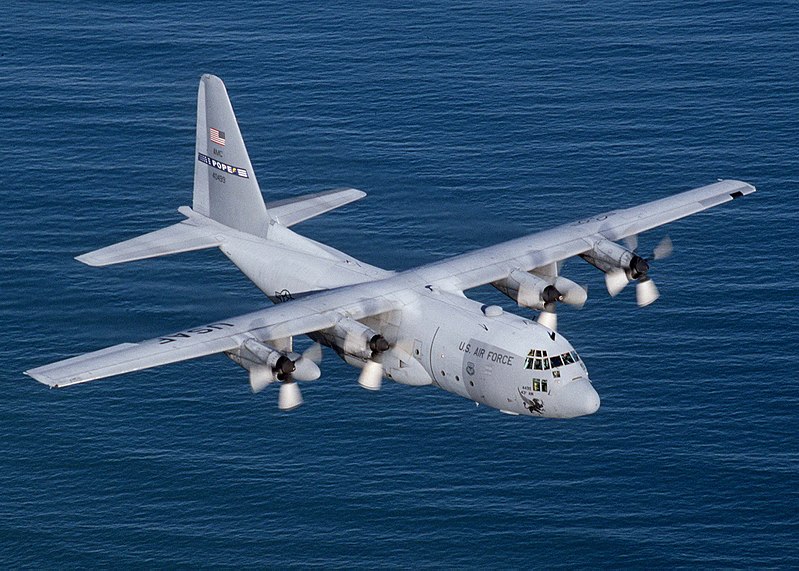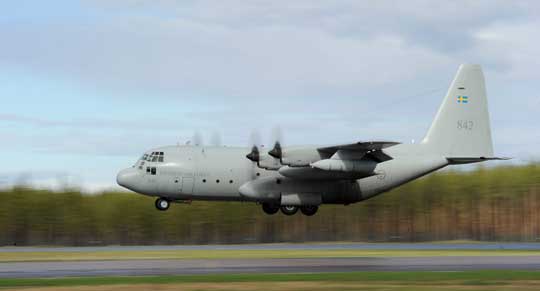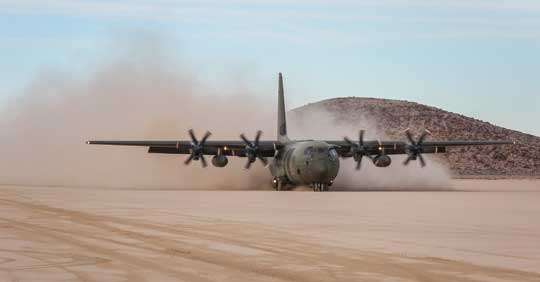
C-130 Hercules transport aircraft in Europe

The Air Force has had the C-130E Hercules transport aircraft for eight years now; Poland currently operates five vehicles of this type. Photo by Piotr Lysakovski
The Lockheed Martin C-130 Hercules is a real icon of military tactical air transport and at the same time a benchmark for other designs of this type in the world. The capabilities and reliability of this type of aircraft have been confirmed by many years of safe operation. It still finds buyers, and previously built units are being modernized and repaired, extending their service life for subsequent years. Today there are fifteen countries on our continent C-130 Hercules.
Austria
Austria has three C-130K medium transport aircraft, which in 2003-2004 were obtained from the RAF stocks and replaced the CASA CN-235-300 transport aircraft. They regularly support the Austrian mission in Kosovo and, if necessary, are also used to evacuate citizens from threatened areas. The aircraft acquired by Austria are a version specially adapted for British needs and its equipment can be compared with machines of this type in options E and H. According to the available resource - after modernization - the Austrian C-130K will be able to remain in service at least until 2025. They report to the Kommando Luftunterstützung and operate under the Lufttransportstaffel from Linz-Hörsching Airport.

Austria has three medium sized C-130K transport aircraft sourced from British military aviation stocks. They will remain in service until at least 2025. Bandeshir
Belgium
The aviation component of the Belgian Armed Forces is equipped with 11 C-130 transport aircraft in modifications E (1) and H (10). Of the twelve C-130Hs that entered service between 1972 and 1973, ten remain operational. Two vehicles were lost in service; To cover the losses, Belgium in the United States acquired an additional C-130E carrier. The aircraft consistently underwent scheduled repairs and were constantly modernized, including the replacement of wings and avionics. They are expected to remain in service until at least 2020. Belgium did not decide to purchase new C-130Js, but joined the Airbus Defense and Space A400M program. In total, it is planned to introduce seven machines of this type into the lineup. Belgian S-130s serve as part of the 20th squadron from the Melsbroek base (15th transport aviation wing).
Denmark
Denmark has been using the C-130 for a long time. At present, the Danish military aviation is armed with C-130J-30 aircraft, i.е. an extended version of the latest Hercules aircraft. Previously, the Danes had 3 cars of this type in the H version, which were delivered in the seventies of the last century. They were resold to Egypt in 2004. They were replaced by four new transport aircraft, the deliveries of which ended in 2007. The stretched C-130J-30 can take on board 92 instead of 128 soldiers with personal equipment. The aircraft serve in the Air Transport Wing Aalborg Transport Wing (721 Squadron) based at Aalborg Airport. They are regularly used to support international missions involving the Danish Armed Forces.
France
France is one of the largest users of the C-130 in Europe and currently has 14 of the type in the H version. The French version is a stretched version of the C-130H-30 with similar dimensions to the latest C-130-J-30s. to the squadron 02.061 "Franche-Comte", stationed at the base 123 Orleans-Brisy. The first 12 cars were accepted until 1987. Two more were bought later in Zaire. The French Air Force's C-130Hs will eventually be replaced by the A400Ms, which are slowly being adopted by the French Air Force and put into service. Due to delays in the A400M program, France ordered an additional four C-130s (with an option for two more) and decided to create a combined unit with aircraft of this type together with Germany (this year the German government announced that it intends to buy 6 C-130J with delivery in 2019). In addition to the transport version of the KC-130J, France also opted for a multi-purpose transport and refueling version of the KC-130J (each purchased in the amount of two pieces).
Greece
The Greeks use C-130 in two ways. The most popular is version H, which has 8 copies, but the aircraft is one of the earliest modifications, i.e. B, are still in use - there are five of them in stock. In version "B" of the aircraft, the avionics were modernized with adaptation to modern standards. In addition to transport vehicles, the Greeks have two more electronic reconnaissance aircraft in the basic version of H. In addition, two instances of H were lost during operation. Like the B version, the H version also underwent an avionics upgrade (both versions were modified by the Hellenic Aerospace Industry in 2006-2010). C-130H aircraft entered service in 1975. Then, in the 130s, used C-356Bs were purchased from the USA. They are part of the XNUMXth Tactical Transport Squadron and are stationed at Elefsis Base.
Spain
Spain has 12 S-130 aircraft in three modifications. The force is based on 130 standard C-7H transport units, one of which is an extended version of the C-130H-30, and the other five are the aerial refueling version of the KC-130H. The aircraft are grouped into the 311th and 312th squadrons from the 31st wing based in Zaragoza. 312 Squadron is responsible for air refueling. Spanish aircraft are marked T-10 for transport workers and TK-10 for tankers. The first Hercules entered the line in 1973. Spanish S-130s have been upgraded to stay in service for a long time. Ultimately, Spain should switch to A400M transport aircraft, but due to financial problems, the future of transport aviation is unclear.

Loading a medical container into a Spanish C-130. Under the ramp you can see the so-called. milk stool to prevent the front of the aircraft from lifting up. Spanish Air Force photo
The Netherlands
The Netherlands has 4 aircraft of the C-130 H version, two of them are a stretched version. The aircraft serve as part of the 336th Transport Squadron based at Eindhoven Airport. The C-130H-30 was ordered in 1993 and both were delivered the following year. The next two were ordered in 2004 and delivered in 2010. The aircraft were given proper names in honor of the pilots important to the history of the country: G-273 "Ben Swagerman", G-275 "Jop Müller", G-781 "Bob Van der Stock”, G-988 “Willem den Toom”. The vehicles are heavily used for humanitarian aid tasks and to recruit the Dutch for overseas missions.

The Netherlands has four Lockheed Martin C-130H Hercules transport aircraft, two of which are transport workers in the so-called. an extended version of the C-130N-30. Photo by RNAF
Norwegia
The Norwegians used 6 medium transport aircraft C-130 in the short H version for many years, but after many years they decided to replace them with more modern transport aircraft in the J variant, in the extended version. The C-130H entered service in 1969 and flew until 2008. Norway ordered and received five C-2008J-2010s in 130–30; one of them crashed in 2012, but in the same year another car of this type was purchased to replace it. C-130J-30s belong to 335 Squadron Gardermoen Air Base.
Poland
Our Air Force has been using S-130 transporters in version E for eight years now. Poland has five vehicles of this type with tail numbers from 1501 to 1505 and proper names: "Queen" (1501), "Cobra" (1502), "Charlene" (1504 d.) and "Dreamliner" (1505). Copy 1503 has no title. All five are based at the 33rd transport aviation base in Powidzie. The vehicles were transferred to us under the Foreign Military Funding support program from the US Air Force depots and were repaired before delivery to ensure their continued safe use. The machines are serviced and serviced on a permanent basis in Powidzie and WZL No. 2 SA in Bydgoszcz. From the very beginning, they were intensively used to support the Polish armed forces in foreign missions.
Portugal

Portuguese transport aircraft C-130 Hercules. In the upper part of the body there was a navigation and observation dome, the so-called. astro dome. Photo Portuguese Air Force
Portugal has 5 C-130 H-versions, three of which are stretched versions. They are part of the 501st Bison Squadron and are based in Montijo. The first Hercules entered the Portuguese Air Force in 1977. Since then, Portuguese C-130Hs have logged over 70 hours in the air. Last year, one machine of this type was lost, and one of the remaining five is in an unairable condition.
Romania
Romania is one of the countries using the oldest C-130 on our continent. It currently has four C-130s, three of which are B and one H. All aircraft are located at the 90th Air Transport Base located at the Henri Coanda International Airport near Bucharest. In addition to the S-130, other Romanian transport vehicles and a presidential aircraft are also stationed at the base. The first S-130 version B was delivered to the country in 1996. Three more were delivered in subsequent years. Aircraft in modification B come from the stocks of the US Air Force, while the C-130H, received in 2007, previously served in the Italian aviation. Although all of them have been upgraded, only three are currently flying, the rest are stored at the Otopeni base.

One of three Romanian C-130Bs in flight. Photo Romanian Air Force
Sweden
This country became the first user of the C-130 in Europe and uses 6 vehicles of this type, five of which are the transport version of the H and one version for air refueling, also a derivative of this model. In total, the country accepted eight Hercules, but the two oldest C-130Es, which entered service in the 2014s, were decommissioned in 130. The C-1981Hs entered service in 130 and are relatively new and well maintained. They have also been upgraded. The C-84 in Sweden is marked TP 2020. One of the problems for Swedish transport workers is the rules coming into force in 8, which tighten the requirements for on-board equipment when flying in civil controlled airspace. On May 2030 of this year, it was decided to suspend plans for the purchase of new transport aircraft and the modernization of existing ones. The main emphasis will be placed on the modernization of avionics, and its operation should be possible at least until 2020. The planned upgrade is to be carried out in 2024-XNUMX.

Swedish C-130H Hercules adapted for aerial refueling. This country became the first user of this type of aircraft in Europe. Photo Swedish Air Force
Turkey
Turkey uses rather old modifications of the C-130B and E. Six C-130Bs were acquired in 1991-1992, and fourteen C-130Es were put into service in two tranches. The first 8 machines of this type were purchased in 1964-1974, the next six were purchased from Saudi Arabia in 2011. One machine from the first batch was broken in 1968. All of them are equipment of the 12th Main Air Transport Base located in the city of Saudi Arabia. central Anatolia, city of Kayseri. Aircraft fly from Erkilet International Airport as part of the 222 Squadron, and the military base itself is also the base for the C-160 aircraft, which are being phased out of service, and the recently introduced A400M aircraft. The Turks modernized their aircraft, trying to gradually increase the involvement of their own industry in this process, which is a phenomenon characteristic of the entire Turkish army.
Велька Britain
The UK currently uses the C-130 only in the new J variant, and the base for them is RAF Brize Norton (previously, since 1967, machines of this type were used in the K variant). The aircraft are adapted to British needs and have the local designation C4 or C5. All 24 units purchased are equipment from XXIV, 30 and 47 Squadrons, the first of which is engaged in operational training of C-130J and A400M aircraft. The C5 version is the short version, while the C4 designation corresponds to the "long" C-130J-30. British aircraft of this type will remain in service with the RAF until at least 2030, although they were originally planned to be withdrawn in 2022. It all depends on the pace of deployment of new aircraft A400M.

A British C-130J Hercules is arriving in the US this year to take part in the Red Flag international air exercise. Photo by RAAF
Włochy
Today, there are 19 Hercules J variants in Italian military aviation, three of which are KC-130J tanker aircraft, and the rest are classic C-130J transport aircraft. They were put into service in 2000-2005 and belong to the 46th Aviation Brigade from Pisa San, being the equipment of the 2nd and 50th squadrons. The Italians have both classic C-130J transports and extended vehicles. An interesting option is designed to transport patients with infectious diseases with their complete isolation. In total, 22 C-130J transports were purchased for the Italian military aviation (they replaced older C-130H aircraft, the last of which was withdrawn from the line in 2002), two of which were lost during operation in 2009 and 2014.
Situation in the European market
As far as transport aircraft are concerned, the European market today is quite difficult for Lockheed Martin, the manufacturer of the legendary Hercules. Domestic competition has long been strong, and an additional challenge for US products is also the fact that several countries work together in joint aviation programs. So it was with the C-160 Transall transport aircraft, which is gradually coming off the assembly line, and with the A400M, which is just coming into use. The latter vehicle is larger than the Hercules and is capable of carrying out strategic transport, as well as performing tactical tasks, which the S-130 specializes in. Its introduction basically closes purchases in countries such as the UK, France, Germany and Spain.
Another serious problem for European buyers is limited funding for weapons. Even wealthy Sweden decided not to buy new transporters, but only to modernize existing ones.
The market for used aircraft is large, which allows us to offer upgrade packages and services related to keeping aircraft in combat readiness for many years to come. Today, aircraft stand in line for 40 or 50 years, which means that the buyer is tied to the manufacturer for so many years. It also means at least one major upgrade of the aircraft, plus possible additional modification packages that increase its capabilities. Of course, in order for this to be possible, the aircraft must first be sold. Therefore, despite the lack of new orders from the richest countries in Europe, there is still the prospect of about a dozen years of support for already used cars.
One solution for smaller countries that need to modernize their fleet is a multitasking approach. When used in combat aviation, it can work well in transport aviation as well. Purchasing aircraft with capabilities limited only to the transport of goods and people can be difficult to justify, especially if the equipment is still in working order. However, if you look at the issue more broadly and decide to purchase aircraft that, in addition to their transport capacity, will be suitable for refueling helicopters, supporting special missions or supporting on the battlefield in asymmetric conflicts or reconnaissance missions, the purchase of C-130 aircraft takes on a completely different meaning.
Everything, as usual, will depend on the available money and should come down to calculating the potential profit from the purchase of specific modifications of the S-130. Aircraft in a multi-purpose configuration must necessarily be more expensive than standard transport modifications.
Potential buyers of S-130
Countries already using older versions seem like the most likely recipients of the new transport aircraft. Although there is a gap between the variation of J from H and E, but this will be a conversion to a new version, and not to a completely different plane. The infrastructure will also, in principle, be largely ready to accommodate the new machines. As already mentioned, Sweden dropped out of the group of potential buyers and decided to upgrade.
The group of buyers is definitely Poland, with demand for four or six cars. Another country that needs to exchange its transport equipment is Romania. Has old copies in version B, although it is in the pool of countries with high needs and a limited budget. In addition, he also has C-27J Spartan aircraft, which, although smaller in size, do their job well. Another possible buyer is Austria, which uses ex-British C-130Ks. Their service time is limited, and given the conversion process and the queue of deliveries, the deadline for negotiations is in the near future. In the case of smaller countries like Austria, it is also possible to apply a combined transport component solution with another country in the region. Like Romania, Bulgaria has also opted for smaller Spartans, so acquiring a new type of medium transport aircraft is unlikely. Greece may also become a potential buyer of the S-130, but the country is struggling with serious financial problems and plans to modernize its combat aircraft first of all, as well as purchase anti-aircraft and anti-missile air defense systems. Portugal uses C-130Hs but tends to buy Embraer KC-390s. So far, not a single option has been finalized, but the chances of converting H machines into J machines are estimated as ghostly.
Turkey seems to have the biggest potential. It has a large fleet of obsolete B-type aircraft and C-160 aircraft, which will also soon need to be replaced with a new type. It is in the A400M program, but the ordered copies will not cover the entire demand for transport aircraft. One of the problems with these purchases may be the recent deterioration of US-Turkish diplomatic relations and the desire to maximize the autonomy of their own military industry.
